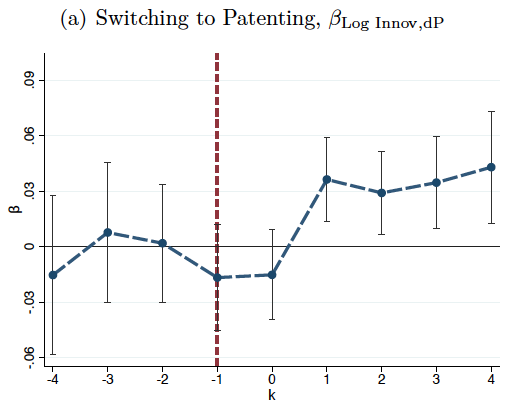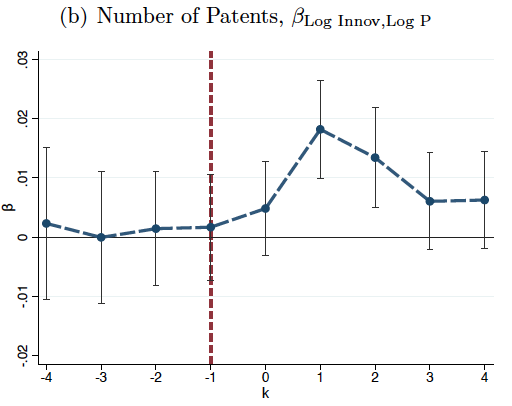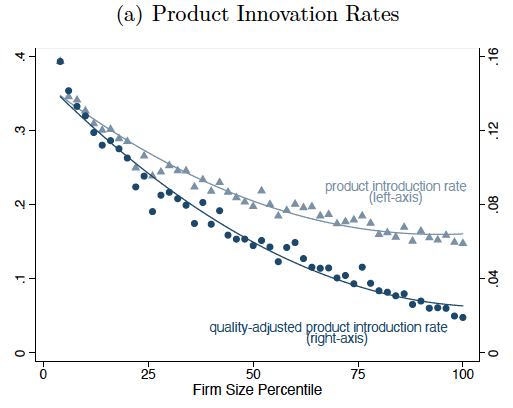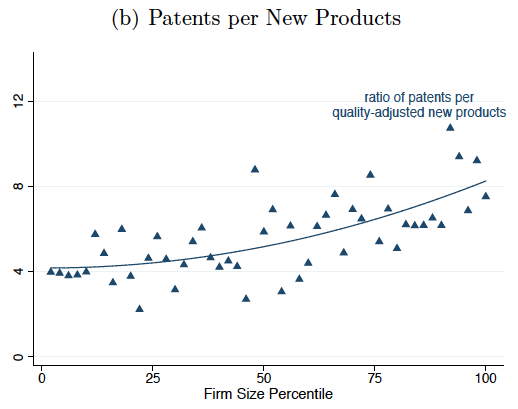Patents are at the centre of policies designed to incentivise innovation and productivity growth. In the absence of specific data tracking actual innovations introduced in the marketplace, patent statistics are often used by policymakers and economists to represent observable and broadly available measures of potential inventions. Firms, industries, or countries with more patents are considered to be more innovative; R&D subsidies are considered to be effective if they lead to a larger number of patent filings.
Yet patents are a protective tool that firms can use to pre-empt competitors from entering their product market space. This protection may be especially valuable for large market leaders because of greater incentives to defend their existing lead. Indeed, in recent years, patenting activity has skyrocketed whereas innovation and productivity growth have not (Bloom et al. 2020). Large firms have funnelled more resources into intangible capital – including intellectual property. As these investments did not manifest in perceptible improvements in aggregate productivity, they have increasingly led to concerns about the rising dominance of large firms (Crouzet and Eberly 2019, Autor et al. 2020).
For this reason, understanding how patents relate to actual innovation in the market as opposed to firms’ strategies to protect their incumbent positions is crucial for an informed policy debate on patent system reforms (Federal Trade Commission 2003). The lack of large-scale systematic evidence on the nature of the relationship between patents and innovation is largely due to data limitations. In our recent paper (Argente et al. 2020), we hence construct a new dataset to study the relationship between patents and actual product innovation – the introduction of new and improved products to the market – and how this relationship varies with firms’ market share.
Text analysis of patent documents and firm product portfolios
In our study, we construct a new dataset linking product innovations in the consumer goods sector to their respective patents. We use the Nielsen-Kilts scanner data set to obtain detailed information on firms’ product offerings from 2006 to 2015 at the finest level of disaggregation – barcodes. By tracking information on each product’s attributes, entry date, sales, and price, we construct various measures of product innovation using the number of new products as well as the quality-adjusted number of new products introduced by firms in specific product categories. We infer quality improvements by tracking the new attributes (e.g. formula, style, content) that a product brings to the market and by exploiting variation in product prices and sales. We then link product innovations to their respective patents from the US Patents and Trademarks Office using text analysis of product descriptions and patent documents. Patent documents contain rich technical information on content of the claimed invention. To generate comparable content on the product side, we use short descriptions included in the Nielsen data and extend them with text from Wikipedia articles about the products. We then analyse the text of patent documents and assign each patent to the set of products of the firm with which it has the highest text similarity. For example, after reading the “Low residue cleaning solution comprising a C8 to C10 alkylpolyglucoside and glycerol” patented by The Clorox Company (patent number 12141583), we assign it to the hard-surface cleaner products by Clorox. The resulting granular data set tracks patents and product innovations for firms in the consumer goods sector over time.
Patents as a measure of innovation
Using our data, we begin by documenting how much actual product innovation in the market is accounted for by patenting statistics. To this end, we show that more than half of the product innovations in the consumer goods sector is not associated with any patent. Nevertheless, product innovation in a particular product category strongly increases when a firm files for its first patent in that category. This increase in product innovation after commencement of patenting persists over time, as shown in Figure 1 (a). We also find that firms introduce more and better-quality products around the time of additional patent applications. Figure 1 (b) shows that the correlation between product innovation and the number of patent applications is highest in the year following the patent application, but dies out several years after the application. We find that the elasticity of product innovation to the number of patents filed a year before ranges from 0.02 to 0.04. These elasticities are driven by patent applications that eventually get granted by the Patent Office and patent applications that are more heavily cited by future patents. This suggests that commonly used measures of the quality of patents are informative about product innovation rates.
Figure 1 Product innovation and patenting
Note: The figures depict the estimated coefficients from the regressions of log product innovation at time (t) on a dummy equal to one after the firm’s first patent application (Plot a) and on the log number of patent applications (Plot b) at (t+k).
The role of large firms
What do patent filings tell us about firms’ efforts to innovate as opposed to their reliance on pre-emptive protection strategies? If a firm files patents and at the same time introduces many new and improved-quality products to the market, it is natural to infer that the firm is innovative and that its patent filings manifest as new products that better meet the needs of consumers. However, firms often file for patents that are not followed by the introduction of new and improved products. Such patents may instead serve an anti-competitive/strategic role. With this intuition in mind, we use our data to understand the role of patents for firms with different market positions.
Figure 2 (a) plots the product innovation rates of firms in particular product categories against their relative size (sales) percentile in that product category. The plot shows that market leaders – firms accounting for a large fraction of the market in a particular product category – have lower product introduction rates both in terms of quantity and quality improvements of the new products they introduce. Though larger firms’ innovation rates decline, their patenting intensity increases. Figure 2 (b) shows that market leaders file disproportionately more patents relative to the product innovations they introduce. Overall, although larger firms file for many more patents, these patents result in a less than proportional increase in the rate of product introduction and improvement.
Figure 2 Innovation and patenting by firm size
Note: The figures depict the relationship between product innovation rates (Plot a) and the ratio of patent applications per new products (Plot b) and the market shares of the firms.
Moreover, we find that patents filed by market leaders generate large revenue growth even after controlling for the quantity and quality of the new products that these firms introduce. In contrast, product innovations introduced by smaller firms fully account for the revenue premium associated with their patents. We also show that patent filings by market leaders are associated with a decline in competitors’ product introduction in shared product categories. The same is not true if we consider patent filings of smaller firms.
The private patent value
Using a simple model of firm product innovation and patenting decisions, we provide back of the envelope calculations for the private value of a patent to firms of different sizes in the consumer goods sector. Conceptually, this private patent value consists of two components. The first – the productive component – represents the option value of incorporating a patented idea into new higher-quality products in order to gain additional profits. The second – the protective component – represents the value that the firm earns from preventing its rivals from competing in the marketplace. Our results show that 43% of the average patent value is accounted for by the protective component of patent value and that this share increases substantially with firm size.
Conclusions
Our results show that, on average, patent filings do result in new products being introduced to the marketplace, but that this rate of conversion of patents into products is lower for market leaders. Our results suggest that patents of market leaders play a key role in constraining the product innovation of their competitors and thereby in protecting the sales of their existing products. These findings have two important policy implications. First, they show that the relationship between patents and innovation changes with firm size and that standard patent-based measures of innovativeness at the firm level may neglect differences in actual innovation across firms of different sizes. Second, they indicate that larger firms are more likely to exploit the patent system to their benefit by using it to protect their market positions instead of introducing actual innovations. This implies that the design of innovation policies should acknowledge that the incentives and motivations to use the patent system vary greatly depending on a firm’s existing market position.
In their book, Jaffe and Lerner (2004) describe the seemingly innocent changes in patent policies in the early 1980s that, as they argue, significantly affected firms’ incentives toward strategic patent filing. In line with this, the survey results published by Cohen et al. (2014) suggest that relative to the early 1980s, large firms now report that the strategic role of patents in protecting their sales from competitors to be more important. A potential avenue for future research is to quantify how large firms’ increasing reliance on protective patenting has contributed to the recent trends of increasing dominance of large firms and declining business dynamism (Decker et al. 2016, Akcigit and Ates 2019).
Authors’ note: The views expressed in this article do not necessarily represent the views of the Federal Reserve System.
References
Akcigit, U and S T Ates (2019), “What Happened to U.S. Business Dynamism?”, Working Paper 25756, National Bureau of Economic Research, April.
Argente, D, S Baslandze, D Hanley and S Moreira (2020), “Patents to Products: Product Innovation and Firm Dynamics”, Discussion Paper 14692, Centre for Economic Policy Research, May.
Autor, D, D Dorn, L F Katz, C Patterson and J Van Reenen (2020), “The Fall of the Labor Share and the Rise of Superstar Firms”, The Quarterly Journal of Economics 135(2): 645-709.
Bloom, N, C I Jones, J Van Reenen and M Webb (2020), “Are Ideas Getting Harder to Find?”, American Economic Review 110(4): 1104-44.
Cohen, W M, R R Nelson and J P Walsh (2000), “Protecting their intellectual assets: Appropriability conditions and why US manufacturing firms patent (or not)”, Technical Report, NBER.
Crouzet, N and J C Eberly (2019), “Understanding Weak Capital Investment: the Role of Market Concentration and Intangibles”, NBER Working Paper 25869, May.
Decker, R A, J Haltiwanger, R S Jarmin and J Miranda (2016), “Declining Business Dynamism: What We Know and the Way Forward”, American Economic Review 106(5): 203–07.
Federal Trade Commission (2003), To Promote Innovation: The Proper Balance of Competition and Patent Law and Policy.
Jaffe, A B and J Lerner (2004), Innovation and Its Discontents: How Our Broken Patent System is Endangering Innovation and Progress, and What to Do About It, Princeton: Princeton University Press.












